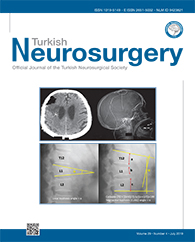2Marmara University School of Medicine, Department of Pharmacology, Istanbul, Turkey
3Eastern Mediterranean University School of Medicine, Famagusta, North Cyprus via Mersin 10, Turkey DOI : 10.5137/1019-5149.JTN.23019-18.3 AIM: To compare neurodegenerative changes using the Fluoro-Jade B staining, following status epilepticus induced by intraamygdaloid injection of kainic acid in Genetic Absence Epilepsy Rats from Strasbourg (GAERS) and non-epileptic control Wistar rats.
MATERIAL and METHODS: A single unilateral intra-amygdaloid kainic acid (750 ng) was administered in adult male GAERS and Wistar rats to induce status epilepticus. We recorded electroencephalogram (EEG) and behavioral changes throughout the experiments. After 1 week of the kainic acid injection, rats were sacrificed, and the brains were removed. We obtained 20μm sections and processed them for Fluoro-Jade B and Nissl staining, which were evaluated semi-quantitatively.
RESULTS: Following kainic acid injections, status epilepticus developed in all rats. In GAERS rats, motor seizures were considerably delayed, with no statistically significant difference in the number of seizures. However, statistically significant differences were observed in the Fluoro-Jade B staining in GAERS rats between contralateral and ipsilateral sides of the CA3, CA1, somatosensory cortex, entorhinal cortex, piriform cortex, reticular nucleus, putamen, and claustrum. In Wistar rats, the CA3, CA1, somatosensory cortex, entorhinal cortex, piriform cortex, reticular nucleus, amygdala, and laterodorsal nucleus exhibited significant differences. Comparing GAERS and Wistar rats, a statistically significant difference was observed for both sides of CA1. In both groups, the staining was prominent ipsilaterally, except for the claustrum in GAERS rats. However, the motor cortex remained unaffected in both groups. Neurodegenerative changes were not associated with the severity of seizures in both groups following the intra-amygdaloid kainic acid administration.
CONCLUSION: This study demonstrates that CA1 is the only region exhibiting a statistically significant difference between Wistar and GAERS rats.
Keywords : Genetic absence epilepsy rats, Flouro-Jade B, Status epilepticus, Amygdala, CA3, Neuroscience, Absence epilepsy, Kainic acid, GAERS




